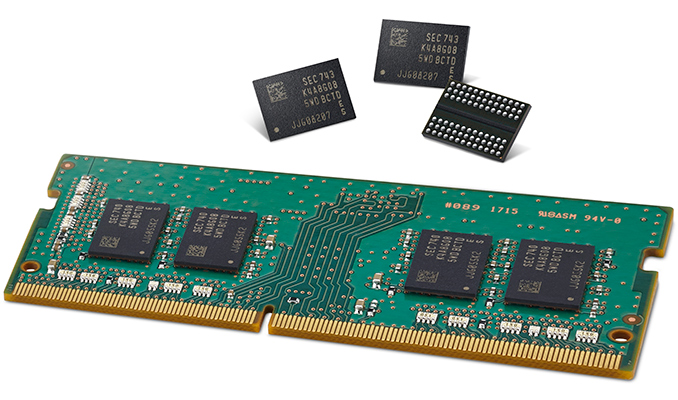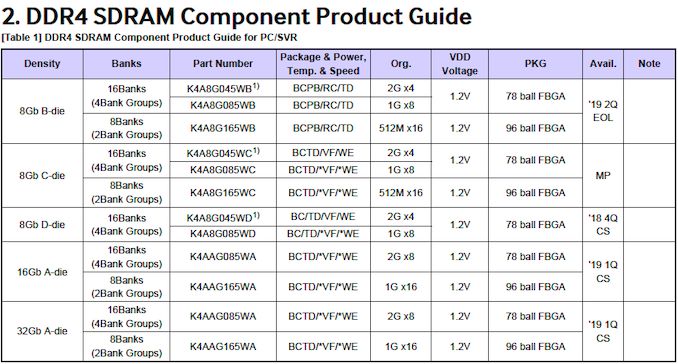Samsung to End B-Die DDR4: The Overclockers' Favorite
by Anton Shilov on May 14, 2019 3:00 PM EST
For many years leading DRAM module manufacturers have used Samsung’s B-die 8 Gb memory chips for their fastest and most advanced DIMMs. This quarter Samsung intends to discontinue production of B-die, forcing its partners to find a worthy replacement.
According to Samsung’s most recent Product Guide, the company will EOL its B-die 8 Gb memory chips in Q2 2019. It is not particularly clear when exactly Samsung ceases to make its legendary memory chips, but it looks like it is time for companies like Corsair or G.Skill to stock pile B-die ICs for existing DDR4-4000 and faster kits.
Samsung will continue to produce C-die and D-die 8 Gb memory chips using its 10 nm-class process technologies. Officially rated for DDR4-3200 and DDR4-3600 speed bins, these ICs have been in production since 2016 and 2017 respectively. By now, these memory devices have to be mature enough for high-end memory modules, but far not all makers of DIMMs use them for leading-edge products. Also their overclockability beyond those speeds pales in comparison to B-die.
It is worth noting that in the same document, Samsung has listed its 16 Gb A-dies memory devices made using a 10 nm-class process technology that are used to build high-capacity 32 GB UDIMMs and other memory modules required for servers and workstations.
We have reached out to makers of memory modules to find out which memory chips will replace Samsung’s legendary B-die memory chips on high-end modules. We are yet to receive their responses. These products will not disappear overnight, but it looks like their days are numbered.
Related Reading
- Samsung Starts Production of 8 Gb DDR4-3600 ICs Using 2nd Gen 10nm-Class Tech
- Samsung Begins To Produce DDR4 Memory Using '10nm Class' Process Tech
- G.Skill Unveils 64 GB DDR4-4266 and 128 GB DDR4-4000 Kits for HEDTs
- G.Skill Announces DDR4-4800 and DDR4-4500 Kits for Z390 Boards
- Corsair Builds 32 GB DDR4-4333 Kit, Only for Pre-Binned Coffee Lake CPUs
Source: Samsung (via Tom’s Hardware)













16 Comments
View All Comments
Skeptical123 - Tuesday, May 14, 2019 - link
This feels like a weird move by Samsung. But if Samsung is doing it make sense assuming this means C and D chips are more than good enough for most applications. While the high end money maker segment that is the sever market will continue utilizing A chips when performance and density matter.Gasaraki88 - Wednesday, May 15, 2019 - link
It makes sense for Samsung. b-die density is too low and they can make more money from higher density A-die and slower, easier to make C and D die. Server memory is not really high performance anyway. They run standard speeds, not the overclocked XMP profiles or regular DDR4 performance memory.Dragonstongue - Tuesday, May 14, 2019 - link
likely because they are "too good" so they instead focus on others that likely just hit rated spec (in most cases)I heard the B die not as good multi-channel kits vs some of the other ones who while not as "tight" could handle more capacity (vs many sticks) more easily then B die were capable of.
who knows, more often than not, the only "real"? info we have is from customer feedback or the often "in best case circumstance" information from the product maker in question (which is often all over the place in regards to "actual" real world numbers.
so all the mem makers basically cut production way back from 2019 because of "industry slowdown" (basically they got nailed for price fixing, slow production down have no choice price be right back up if not more after the fact)
is Sammy, so could be the fancy FlarX with awesome C14 at 3200 will be replaced with 3200 at CL16 likely next to no overclock/tighten or some crud.....I not put past them, replace great with mehhh for same price....
frozen_water - Tuesday, May 14, 2019 - link
I suppose it depends upon use case, but I have 4x8GB of cas 14 @ 3200 b die. No issues here and wicked fast performance on Z390. Maybe it’s not good as 8x8GB like on threadripper? And that’s an edge case scenario.DanNeely - Tuesday, May 14, 2019 - link
I'm guessing it's down to it being their oldest 8gb die (their model convention means the C and D dies are newer versions); which makes it the logical one to retire to free fab space as they ramp up on higher capacity 16gb dies instead. Overclocking ram is too niche a product to justify keeping lines open if the C/D dies are more cost effective to produce for the mainstream products that take 99% of the output.svan1971 - Tuesday, May 14, 2019 - link
"it's down to it being their oldest 8gb die" that would be A die and they aren't EOL.Rudde - Tuesday, May 14, 2019 - link
Are you sure that A-die isn't EOL already? They can't be found on the chart.Billy Tallis - Tuesday, May 14, 2019 - link
At least for NAND, Samsung's generation numbering starts with M then proceeds through A, B, C, etc. And each capacity is numbered separately, so a 16Gb A die can usually be expected to be built on a much newer process than an 8Gb A die.DanNeely - Tuesday, May 14, 2019 - link
8gb A is long gone.16gb A is new (the lettering restarts with each new capacity).
Opencg - Tuesday, May 14, 2019 - link
thank you